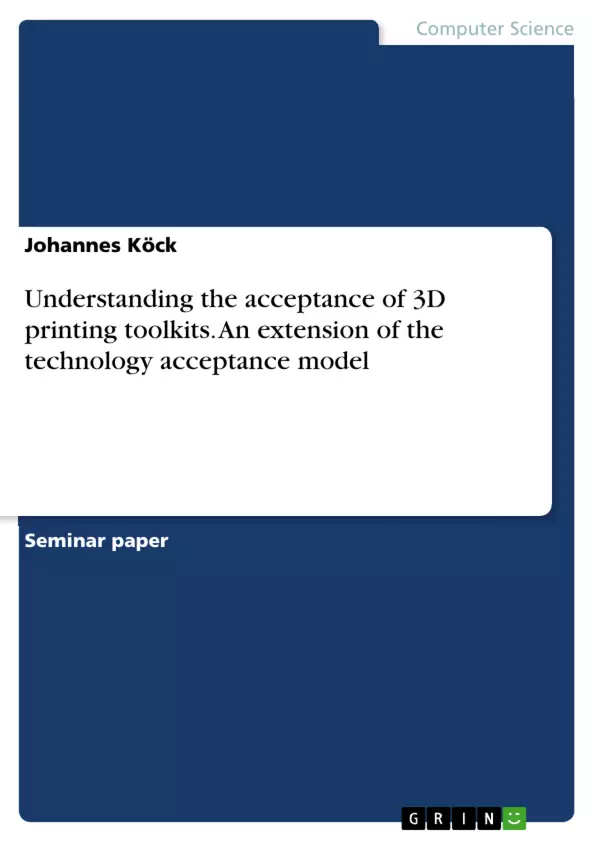The goal of this paper to find out factors that affect the acceptance of 3D printing toolkits. A hypothesized research model for 3D printing toolkits is proposed. Based on a survey of 30 participants this research model is analyzed and evaluated. The result is, that five of these seven proposed determinants have a strong influence on the Behavioral Intention to Use such a toolkit.
Additive manufacturing, also known as 3D printing (3DP), is a technology which gained a lot of interest in recent years. The market is supposed to grow further with a new annual growth record of 35 % in 2013. However, the world leading market report for additive manufacturing, the Wohlers report, states that growth in the upcoming years is especially going to be driven by “3-D printers that cost less than $5,000, as well as the expanded use of the technology for the production of parts, especially metal, that go into final products.” [1] Consequently, the following paper focuses on 3D printing for non-experts as more and more citizens can afford this technology and as there is not a lot of research in the field of information systems about 3D printing on the consumer level. Questions such as “What are the needs of consumers regarding 3D printing? Which are the top products the consumers want to produce? How do these non-experts deal with 3D printing design software?” have not been answered satisfactory yet.
The goal of this paper to find out factors that affect the acceptance of 3D printing toolkits. A hypothesized research model for 3D printing toolkits is proposed. Based on a survey of 30 participants this research model is analyzed and evaluated. The result is, that five of these seven proposed determinants have a strong influence on the Behavioral Intention to Use such a toolkit. There are two different fields of IS research: Behavorial science (BS) and Design Science (DS) [2] [3]. For both fields an effective literature review is the basis. However, while the design-oriented research creates IT artifacts the behavioral research creates theories about these artifacts and tries to check the truth of these theories. Theories that have been found to be empirically adequate, in turn, serve design-oriented researchers for new IT artifacts [2]. Consequently, as this research is based on TAM and as it tries to validate the truth of TAM related to 3DP, this research paradigm is in the field of BS.
Inhaltsverzeichnis (Table of Contents)
- Introduction
- Problem statement
- Research objective
- Research paradigm in Information Systems
- Research model
- Method
- Measurement scales and items
- Study and survey
- Data analysis
- Conclusion
- References
Zielsetzung und Themenschwerpunkte (Objectives and Key Themes)
This paper aims to identify factors influencing the acceptance of 3D printing toolkits. It proposes a research model based on the Technology Acceptance Model (TAM) and analyzes it using data from a survey of 30 participants. The study seeks to evaluate the impact of various determinants on the intention to use 3D printing toolkits.
- Acceptance of 3D printing toolkits
- Technology Acceptance Model (TAM) application
- Factors influencing user intention
- Empirical research through a survey
- Evaluation of research model
Zusammenfassung der Kapitel (Chapter Summaries)
- Introduction: This section outlines the problem statement, research objective, and research paradigm. It highlights the increasing interest in 3D printing technology and the need for research on its consumer-level acceptance.
- Research model: This section introduces the Technology Acceptance Model (TAM) as a framework for understanding technology acceptance. The original TAM, proposed by Davis, Bagozzi, and Warshaw in 1989, and its subsequent extensions are discussed.
- Method: This chapter details the research methodology, including the measurement scales and items used in the survey. It describes the study and survey design to collect data for the analysis.
- Data analysis: This section outlines the methods used to analyze the collected data. It focuses on the correlation statistics and evaluation of the research model.
Schlüsselwörter (Keywords)
This research focuses on the acceptance of 3D printing toolkits, specifically within the realm of consumer use and non-expert users. The core concepts include the Technology Acceptance Model (TAM), its application to understand user behavior, and the identification of key determinants influencing the intention to use 3D printing toolkits. Empirical research methods, including surveys and correlation statistics, are employed to analyze and validate the proposed research model.
- Arbeit zitieren
- Johannes Köck (Autor:in), 2015, Understanding the acceptance of 3D printing toolkits. An extension of the technology acceptance model, München, GRIN Verlag, https://www.hausarbeiten.de/document/378120


